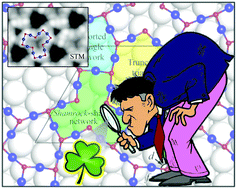In search of non-conventional surface oxidic motifs of Cu on Au(111)†
Abstract
Growing ultrathin oxide layers on metal surfaces presents a new class of low-dimensional nanomaterials with exceptional chemical and physical properties. These “new oxides” can be used in many niche technologies and applications such as nanoscale electronics and heterogeneous nanocatalysis. In this work, we study the formation of surface oxidic structures and motifs of Cu, supported on the Au(111) substrate, using first-principles density-functional theory calculations in conjunction with an ab initio atomistic thermodynamics model. In particular, we systematically examine and analyze the detailed atomic structure and surface energetics of various oxidic motifs of Cu on Au(111), in particular, p2, p2s, p2(6q6) and the newly suggested metastable p2(6q6) + O3, in comparison to both the binary O/Cu(111) and O/Au(111) systems. Depending on the oxygen atmosphere and the type of surface defects introduced in the oxidic layer, various non-conventional, non-hexagonal surface oxidic motifs of Cu could be obtained. Our theoretical results agree with recent scanning tunneling microscopy (STM) experiments and we propose that metastable non-hexagonal surface motifs may pave a way to pursue further studies of these interesting complex surface oxidic layers on various metal supports.


 Please wait while we load your content...
Please wait while we load your content...